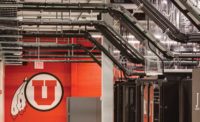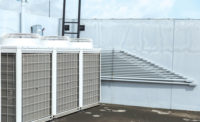Every adaptive-reuse project is complicated, but it’s hard to imagine one more so than the conversion of an office building into an ambulatory, diagnostic surgery center, given the strict requirements for reliability, resilience, and system performance. Complicated doesn’t mean impossible. However, the conversion of this 30-year-old office building into a cancer treatment/surgical center was extremely challenging but successful. The entire team managed to attain LEED Gold certification, provide an N+1 reliability on all critical engineering systems, and receive an ACEC New York Gold award for building/technology systems.
Background
The project involved the adaptive reuse of a vacant 1980s office structure in Middletown, New Jersey, into a regional facility for MSK. Location was one of many the primary considerations. The facility, which is a two-building (north-south), 286,000-gross-square-foot (GSF) structure in Monmouth County, was hardly an ideal candidate for a health care use conversion. Its infrastructure and systems were woefully outdated and not structured to provide the engineered systems necessary for such a program. One of MSK’s objectives is to offer convenience for patient care access, and the site was right off the Garden State Parkway.
The south building is approximately 136,000 square feet for the hospitals clinical program. The north building is approximately 150,000 square feet and is constructed for a data center application. This building also accommodates administrative office space as well as shell space for future growth. Between the two buildings, the facility is designed to accommodate more than 300 staff members.
Aside from typical clinical exam and infusion-type programs, the infrastructure had to support operatory theaters, specimen laboratories, and a UPS-800 compounding pharmacy. The renovation, therefore, was quite a complex process. Each component required approval from multiple regulatory authorities. This was considered through phased construction planning, making sure to allow ample time for signoffs. Fortunately, the design team received strong support from local, state, and federal authorities, which sped things along.
Today, MSK Monmouth provides state-of-the-art diagnostic imaging, radiation oncology, advanced pathology testing, immunotherapy, clinical trials, and genetic testing.
The project team consisted of The Syska Hennessy Group (SHG) as the MEP engineers, Perkins & Will as the architect, Turner Construction as the construction manager, Langan as the civil engineer, and Stratford Engineering as the structural engineer.
For the purposes of this case study, the focus will remain on the MEP engineering and sustainable design.
“Based upon the complexities of an outpatient-type health care facility, compounded by one of the most stringent programs, namely operatory theatres, we needed to think outside the box for this design and be smart about our equipment selection and system applications. The integration process between our design engineering team, plant operations and construction management firm were paramount in collaboratively making the project successful in terms of a physical constraint’s installation perspective, to overall operational efficiency and reliability.”
— Steven Friedman, P.E., CHFM, HFDP, LEED AP, director of facilities engineering, design, and construction for Memorial Sloan Kettering Cancer Center (MSK).
Key Engineering Decisions
Gut Renovation of Interior Infrastructure and Systems — A decision was made to demolish the MEPFP infrastructure and systems to bring the facility up to current New Jersey building codes, ADA, FGI, and ASHRAE Standard 170 compliance, and LEED requirements. To that end, the existing incoming 15-kV electrical service and distribution switches, substations, and panel boards installed at the ground floor level of the north building were removed and replaced with health care-compliant system components and distribution.

FIGURE 1: A high-efficiency magnetic-bearing chiller. Image courtesy of the Syska Hennessy Group
Additionally, the large penthouse-type commercial-grade air-handling units needed to be removed along with their associated ductwork mains. The existing office complex included a central, water-cooled chiller plant. While this is not the norm for an office complex and would have been an appropriate application for our ambulatory care facility, it was of insufficient size, utilizing a phased-out refrigerant type and located within the same space as the incoming electrical service as well as the existing gas-fire heating plant. All of these factors contributed to the need for a new plant at a different location within the existing structure.
“We need to take a stronger approach to equipment efficiency, reliability, and sustainability at this site. This is the only regional site with a program where patients are fully anesthetized yet is not a 24/7 operation. This must also include reinforcement of all of our incoming utilities to ensure continuity of service for both patients and staff.”
— Kevin Comerford, director of facilities operations for MSK, responsible for all regional sites in New York and New Jersey.
Expansion for Equipment
Although the buildings are large, the patient-centric layout limited available space for upgraded systems and the possibilities for outward expansion were restricted by an unusual complication: MSK Monmouth shares the site with an existing cemetery dating back to the 18th century. For this reason, the decision was made to build upward, constructing a penthouse to house all the high- and low-pressure steam boilers for sterilization as well as hot-water boilers for heating.
With very little opportunity for additional interior mechanical space, all the air-handling units are custom rooftop with service vestibules. This presented a challenge for weight limitations of the existing roof steel structure. The existing steel needed to be reinforced and a new concrete roof slab was required, as one had not previously existed.

FIGURE 2: A high-efficiency condensing boiler plant. Image courtesy of the Syska Hennessy Group
For the chilled water and medical gas plants, space was carved out on the ground level of the south building; however, being a condenser water-cooled chiller plant and with the site constraints, it did not allow for grade-mounted cooling towers. The only option was to place the cooling towers on the roof, and a large weight-bearing system only compounded the previously mentioned structural challenges. Large piping systems, together with low floor-to-deck heights, commonly seen in a commercial construction build, did not lend itself to a harmonious above-celling installation. Coordination of above-ceiling utilities associated with the operating rooms, central sterilization suite, USP 800 compounding pharmacy pathology lab, and PACU required a complete team building information modeling (BIM) effort, including the engineer(s), architect(s), and construction manager(s).
Magnetic Bearing Chillers
As part of the sustainable design charrettes, many energy conservation measures were considered and analyzed. Hospitals utilize a lot of energy to properly function and provide the highest level of environmental care for their staff and patients; this is also true for ambulatory care facilities like MSK Monmouth. The cooling requirements of health care facilities can account for more than 20% of the overall electrical consumption for a site. Therefore, optimizing the operational efficiency of the chilled water plant seemed like the first natural course of action.
With full integration between MSK Facilities Management and SHG, the collaborative decision was to design with magnetic-bearing chillers because of their electrical efficiency, low-maintenance requirements, longer life spans, high performance across a range of outdoor conditions, and low noise emissions. According to the Federal Energy Management Program, “The magnetic bearings allow the compressor to operate without the use of oil for lubrication, which reduces energy losses due to friction and increases the heat transfer efficiency of the chiller because no oil enters the evaporator or the condenser.”
Such features made these chillers the ideal technology for MSK Monmouth, considering they were to be operational for 10-12 months of each year, 24/7.
“We knew from the get-go that this site would present some challenges to covert an office facility to a full-blown acute care, diagnostic and ambulatory surgery center.”
— Thomas Ford, principal, and lead engineer, the Syska Hennessy Group (SHG).
N+1 Reliability
To ensure 24/7 operations and business continuity, SHG designed all mechanical and electrical engineered systems serving critical areas with an N+1 MSK standard (100% redundancy). The standard applies to chillers, boilers, domestic water heaters, pumps, incoming electrical service, and medical gas systems. The team decided on a Tier II-type diesel generator to provide emergency power for these critical systems, which was located in a sound-attenuated weather-proof enclosure outside the facility at grade level. Physical constraints would not allow for a second generator to be installed at this site, so if this generator requires service or planned replacement, there will be no interruption to service. A new double-ended switchgear application allows the facility to connect a roll-up generator. The air handlers for this facility were selected utilizing a “fan wall” application. Designing with multiple smaller fans allows for an N+1 operation, whereas if a single fan fails and/or is in need of service, the balance of them can continue to operate to provide airflow as necessary for continuity of service. This was a smart design feature to ensure system reliability given weight limitations and space constraints on the roof level.

FIGURE 3: Biophilic interventional healing garden. Image courtesy of Perkins + Will
Energy Conservation
MSK has a strong commitment to energy efficiency, sustainability, and community exposure, and, accordingly, strives to reduce the environmental impact of facilities construction and operations. A thoughtful design approach was key to reduce energy use, manage the new and re-use of construction material consumption, and decrease waste to create a healthy environment for patients, staff, and the Monmouth County community.
In keeping with this commitment, the SHG selected and evaluated equipment for maximum energy efficiency and partnered with New Jersey Clean Energy, which led to a collaboration of energy incentive and energy reduction rebates for MSK. The comparison for standard chilled water systems to the use of magnetic-bearing chillers proved to be one of many strong applications. MSK also employed a demand-flow strategy that optimized all components within the chiller plant, which, in aggregate, yielded 35%-40% higher efficiency than that of a typical water-cooled chiller plant. A modular-type condenser boiler system added to the energy efficiency as did displacement ventilation, radiant heat flooring systems, and reduced airflow rates while still maintaining critical space pressurization, even during times of reduced occupancy.

FIGURE 4: A central, sterile, high-pressure steam boiler plant. Image courtesy of the Syska Hennessy Group
Adjustments to the exterior shell of the building also contributed to energy efficiency. As with any aging building, it was paramount to upgrade the shell of this facility to ensure energy code compliance and element infiltration. As such, replacement of the windows; re-insulation of the exterior skin; and a newly insulated, albedo roofing system. The SHG did a detailed analysis and energy model to employ energy savings because of the exterior skin and roof upgrades. This analysis and replacement proved to be extremely successful, as the numbers predicted, falling within a 5-8% variance. The variance can be attributed to weather temperature uncertainties and model assumptions.

FIGURE 5: A structure upgrade and facade replacement project. Image courtesy of the Syska Hennessy Group
MSK utilized advanced control applications to enhance overall energy conservation. Examples include:
- a. Optimal Start: Starts HVAC equipment only as early as required to bring the building set points to comfort levels for occupancy;
- b. Optimal Stop: Determines the earliest possible time to initiate setback temperatures before unoccupied periods while maintaining occupant comfort; and
- c. Demand Limiting or Load Shedding: Monitors electric meters and current draw on high-demand equipment and then relaxes set points to immediately reduce demand. This technique can, for instance, not only prevent a chiller from further loading but also globally change HVAC set points throughout the building to shed electric load to avoid peak utility charges.

FIGURE 6: A newly installed patient/staff sky bridge. Image courtesy of the Syska Hennessy Group
To enhance indoor environmental quality, demand control ventilation monitoring of the minimum outside air (cfm) was analyzed for each air-handling unit. Additionally, monitoring the CO2 present at each high-density space was necessary to increase outside air to the spaces requiring additional ventilation during high occupancy. The building automation system (BAS) provides this demand-controlled ventilation strategy.
To reduce water use, SHG utilized low-flow plumbing fixtures that helped minimize the domestic water system use. Stormwater strategies encompassed on-site bioswales and rain gardens, both of which served to reduce the heat-island roof effect and decreased irrigation by 50%.
Such approaches complemented other sustainability measures, namely the use of recycled materials and natural products with low-to-zero volatile organic compounds (VOCs), all of which contributed to the LEED ID+C Gold rating — exceeding MSK’s original objective of LEED Silver.
Conclusion
In the end, despite the challenges, the MSK, P&W, and SHG teams believe the right decision was made to pursue adaptive reuse rather than ground-up construction at this facility. The timelines required to demolish a 286,000-square-foot facility and construct new from the ground up would have long delayed the opening of this facility. This would include design time of a new shell, structure, foundations, new incoming utilities, agency approvals, and, of course, straight construction time to implement the latter.
While the adaptive-reuse process is not easy, given the success of the MSK Monmouth project, the team can personally attest to its feasibility. Being operational now for three years, this facility is beautiful inside and out, creating a warm and comfortable working environment for our staff and more importantly an amazing healing environment for our patients.







